Fallout: New Vegas revisited: the most authentic 3D Fallout game
Revisiting Obsidian's much-loved 2010 RPG.
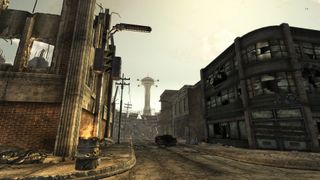
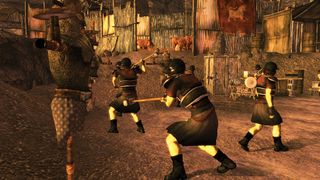
Reinstall invites you to join us in revisiting PC gaming days gone by. Today, we revisit Obsidian's Fallout: New Vegas, which seemingly every comments thread around calls the best one. Read on to see if Andy agrees.
Left for dead, you wake up in the one-horse town of Goodsprings and begin a quest for vengeance in the Mojave Wasteland. That’s the beautifully simple setup for Fallout: New Vegas, which makes the vault sequence in Fallout 3, where you watch your character grow up, seem needlessly long-winded. After a quick chat with a local doctor, voiced by Saul Tigh from Battlestar Galactica, you’re set free. And it’s up to you whether you want to hunt down the people who tried to kill you, or just drift aimlessly around the desert like Clint Eastwood’s Man With No Name.
The Mojave is a far cry from the grim, shattered ruins of the Capital Wasteland. This part of the United States wasn’t bombed quite so heavily, and has retained some colour and life over the centuries. Fallout 3 was a sea of blues and greys, but New Vegas sizzles with oranges and reds. It’s a more vibrant post-apocalyptic wasteland, but still tinged with the melancholy, desolate tone that defines the Fallout series. You begin the game on the edge of the desert among isolated towns and rolling tumbleweed, then move closer to New Vegas itself, where civilisation has a stronger foothold.
"So much of Fallout is bleak," says writer and designer Eric Fenstermaker in a 'making of' film included in the Collector's Edition. "Everything has been blown up, but the New Vegas Strip is unique in that no nuclear weapons hit it. So when you go in you’re immediately struck by the fact that this is one of the last places that still feels like the old world." And although the reveal of the Strip isn’t as impressive as it could have been—a result of the slightly creaky, ugly engine the game was built in—it’s still interesting to explore an area of Fallout’s wasteland that isn’t totally ruined.
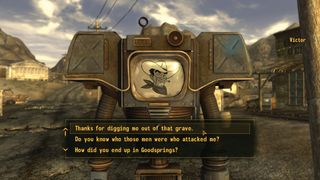
West world
But the Mojave has a very different feel when you wander out to the edges of the map, feeling more like an old western—an atmosphere enhanced by the catchy cowboy ballads that play on your Pip-Boy’s radio. "I took a motorcycle trip through the desert and went all around the outskirts of Las Vegas," says project director Josh Sawyer in the same making of film. "Travelling by motorcycle, you get a lot more opportunities to see the world around you. And it gave me a really strong feeling of what it’s like being out there in the desert, which I then tried to bring into the game."
A slick, smooth-talking New Vegas gangster called Benny, played brilliantly by Matthew 'Chandler Bing' Perry, left you for dead at the start of the game, and chasing him is, at least to begin with, the focus of the story. Benny’s appearance, specifically his garish black-and-white plaid suit, is based on real-world Vegas gangster Bugsy Siegel—one of many historical figures Obsidian looked to for inspiration when creating the game’s characters. But in the big picture, Benny is small time compared to some of the other antagonists you’ll encounter in the Mojave.
There’s the enigmatic Mr House, inspired by infamous Vegas businessman Howard Hughes. He’s a pragmatist, and even a force for good in the wasteland in some ways. But you don’t get that powerful without a certain level of ruthlessness. Then there’s Caesar’s Legion, a tribal army planning to assault and capture the New Vegas Strip and nearby Hoover Dam, whose preferred method of dealing with enemies is crucifying them. And there are other, smaller groups, too, including the Powder Gangers, the Boomers and the Jackals. You’re never short of enemies in New Vegas.
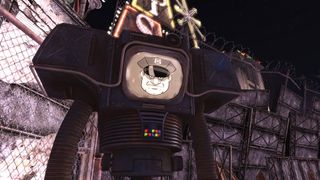
One of New Vegas’ best tricks is sidelining the binary karma system for reputation. Karma is still there, but it has much less bearing on the game. How the factions perceive you is a lot more important, and it’s worth making a few friends. Get cosy with the Brotherhood of Steel and they’ll give you access to their safehouse and occasionally fill a crate with energy weapons and ammo. But anger them and Veronica—one of the better companions—will refuse to join you. Pal up with the New California Republic and you’ll get a radio that lets you call for backup and supply drops. Upset them and they’ll send a hit squad in your direction.
The biggest gaming news, reviews and hardware deals
Keep up to date with the most important stories and the best deals, as picked by the PC Gamer team.
But the game’s greatest strength, and the reason many consider it the best of the 3D Fallout games, is the writing. Obsidian has a solid background in storytelling, and it shows in New Vegas. Quests are more interesting, with a moral greyness that Fallout 3 sorely lacked. In a GDC talk about designing its branching narrative, Sawyer said he wanted to avoid 'Jesus/Hitler' moments: those blunt choices where one option is selfless and noble, and the other is comically evil. "The agony of a choice should fall somewhere between these two spectrums," he says in the talk. "A player should feel like there’s something good and bad about what they pick."
New Vegas doesn’t have the moral ambiguity of some of Obsidian’s other games, particularly the magnificent Pillars of Eternity, but it’s one of the things that sets this Fallout apart from the Bethesda entries in the series. Arguably, though, the Mojave isn’t as evocative a setting as the Capital Wasteland. Civilisation's post-nuclear collapse is felt more vividly in Washington DC. It has a bleakness that you never really get a sense of in the Mojave. That was almost certainly Obsidian's intention, to show us another side of the Fallout setting, but there’s something more compelling about the hopelessness of the Capital Wasteland on that level.
Allied assault
But in pretty much every other respect, Fallout: New Vegas is the better game. Many of the companions are rich, interesting characters with distinctive personalities, and not just dumb automatons following you around. There are more ways to talk and think your way out of trouble. And the faction system makes it enormously replayable. In one playthrough you might side with the NCR to protect the Hoover Dam; in the next you'll buddy up with Caesar's Legion and help them capture it. And depending on who you decide to join forces with, some missions will close off and others will open up. Your allegiances really do have an impact on the game.
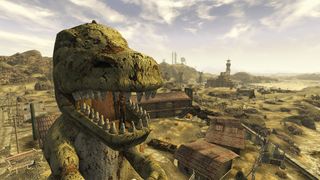
Some of the worst things about New Vegas—dead-eyed character models, janky animation, feeble FPS combat—were inherited from Fallout 3, so I can’t really blame Obsidian for much of that. Overall, it did an incredible job, especially when you consider that it created the entire thing in just 18 months. It also found time to make some quality of life improvements, including a radial menu that lets you easily give orders to your companions, and weapon mods. It even added a survival mode that forces you to eat, sleep, and drink to stave off death, and where companions can die permanently if they take too much damage.
The debate about which 3D Fallout is best has been raging for years, and probably will forever. But for my money, New Vegas is the clear winner. Obsidian’s historical ties to the series and its deep understanding of the lore—thanks to the involvement of 'Fallout Bible' writer Chris Avellone—makes for a much more consistent, authentic take on the setting. The quests are more entertaining and varied, the characters are stronger, and the faction system makes it a much richer role-playing experience. I don't know if Obsidian will ever make another game in the series, but I'd love to see it take another yank of the one-armed bandit.
If it’s set in space, Andy will probably write about it. He loves sci-fi, adventure games, taking screenshots, Twin Peaks, weird sims, Alien: Isolation, and anything with a good story.
Most Popular


